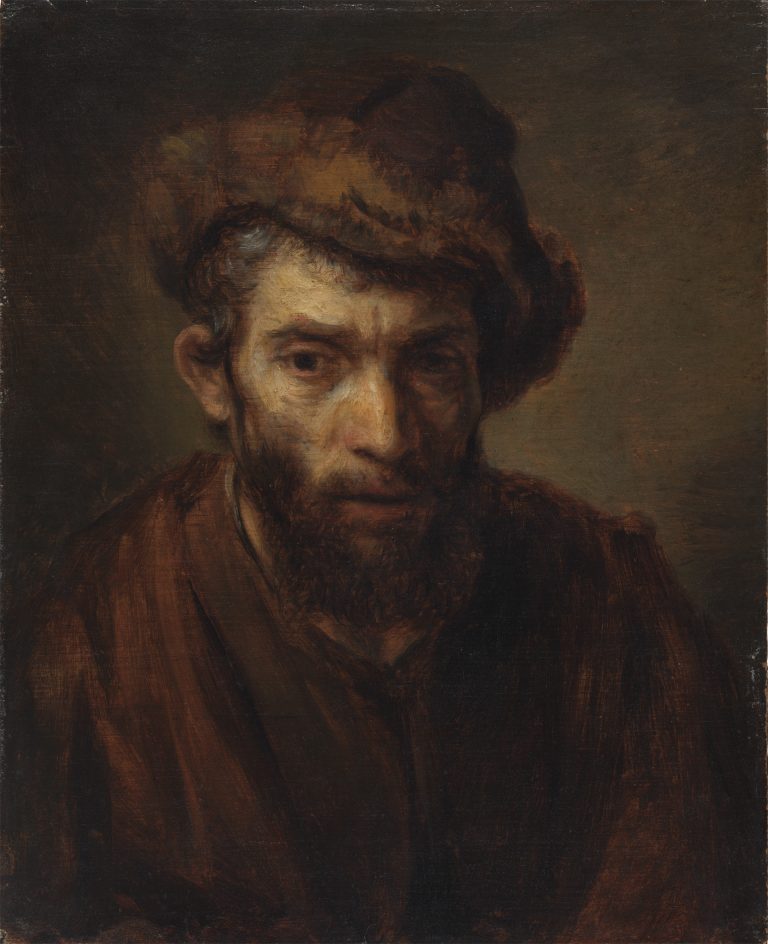A man with a long thin face accentuated by prominent cheekbones and a strong nose confronts the viewer with an intense, yet slightly averted, gaze. His parted lips and furrowed brow suggest that he is deep in thought. Lending drama to his appearance is the way raking light illuminates the left side of his face, while catching a few sharp features on its shaded right. The expressive force of this head suggests that the painting is not a portrait, but a character study, commonly referred to in Dutch art as a tronie.1
The restrained painterly effect and the contained emotion of the figure place this work among those painted by Rembrandt van Rijn (1606–69) and his followers in Amsterdam in the 1640s. Evidence for this context is provided by an etching dated 1646 (fig 1) made by Samuel van Hoogstraten (1627–78), one of Rembrandt’s students, after the original composition, or a version of it.2 Equally significantly, this head study is known in at least four extant versions, including ones in the Gemäldegalerie, Kassel;3 the Musée du Louvre, Paris;4 and a private collection in Toronto.5 This cluster of works conforms to a pattern found in Rembrandt’s workshop where similar versions of a composition are known to exist, likely the result of pedagogical exercises assigned by the master (fig 2).
The bold, open brushstrokes of the present head study relate to those in Rembrandt’s more sketch-like works of the second half of the 1640s, even though the Leiden Collection panel lacks Rembrandt’s decisive touch in evoking mass and structure. For example, the sweeping dry strokes of dead color in the costume and the thicker strokes articulating bone structure around the man’s eye are similar to those in the master’s Portrait Study of a Young Jew of around 1648 in Berlin (fig 3).6 Despite the presence of Van Hoogstraten’s etched image of this sitter, the loose brushwork of this head study differs from the smooth surfaces and soft textures of his paintings during the 1640s. It should be noted, however, that the man’s almond-shaped eyes are similar to those in Van Hoogstraten’s works, as in, for example, his 1647 Adoration of the Shepherds.7
The other extant versions of this composition demonstrate a range of handling and finish, suggesting that they were executed by different hands, although none can be identified. Closest to the present painting is the one in Toronto, but its forms and surfaces are more even. The Kassel version likewise interprets the composition with much greater evenness and smoothness in the facial features, reflecting an inclination toward higher finish, which may indicate a response to later developments in artistic taste. The version in the Louvre, by contrast, shows thick and opaque impasto and simplified forms that may even suggest eighteenth-century origins.8
The bold effect of open brushwork in the Leiden Collection panel speaks strongly against the suggestion that this work was painted by Constantijn Daniel van Renesse (1626–80), whose handling of paint never progressed beyond the hesitant and finicky, and whose range of emotional expression was limited.9 Only the somber mood resonates with this pupil’s known works. Furthermore, Van Renesse’s unconventional and limited study with Rembrandt took place later, between 1649 and 1652, and focused on multifigure historical compositions.10 His few single-figure paintings are portraits of family and friends.11 The closest candidate for authorship would be another of Rembrandt’s pupils from the early 1640s, Gerbrand van den Eeckhout (1621–74), who experimented with loose paint handling during this period. Nevertheless, his lively handling of forms and features does not accord with the heavy solidity conjured here by thick, straight strokes of paint. At present this work can only be ascribed to an anonymous pupil in Rembrandt’s workshop around 1645.
For Rembrandt’s pupils the evocation of emotion in the model’s features would have been an important element to study and capture in paint. One may even suggest that this sitter projects a state of inner turmoil, a quality that seems to be suggested by the purported identification of the sitter in Van Hoogstraten’s print. An inscription at the upper left identifies the man as Jan van Leyden (1509?–36), the charismatic Dutch Anabaptist leader who preached radical rejection of worldly authority and briefly seized power in the German city of Münster in 1533 before he was defeated and executed. Van Hoogstraten also produced a companion print after a different painting of an unnamed man, who was later identified as the Quaker martyr James Nailor in a copy of the print.12 Both of these identifications of a controversial historical figure were arbitrary interpretations; each was selected because the depiction fit a particular mental image of the man’s personality.
Although Van Hoogstraten identified the model as a Dutchman, most commentators have seen him as Jewish. His tall fur hat appears to represent the Polish type known as the kalpac, and more specifically the spodic, associated with Polish Jews.13 Equally Polish in flavor is his plain, loosely-fitted garment, which looks like a caftan. While it is always hazardous to base identity on features,14 this man’s distinctive appearance indicates that he was one of the many Ashkenazi Jews who immigrated to the Netherlands starting in the 1630s, and who would have stood out sharply on the streets of Amsterdam.15 His untrimmed beard likewise would have conformed to Ashkenazi Jewish observance, and less to Dutch fashion.
This model, thus, apparently posed for one or more artists in Rembrandt’s studio, and possibly for the master himself, as part of the studio’s practice of studying live models both as exercises and in preparation for history paintings. In their desire for more authentic models for the figures in their Biblical scenes, these artists likely looked to the Jewish residents of Amsterdam rather than to their fellow natives of Northern Europe. In much the same way, they found in Polish, Persian and Turkish costumes indications of correct forms of attire in such scenes.
